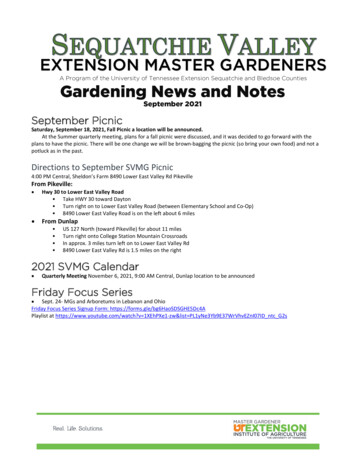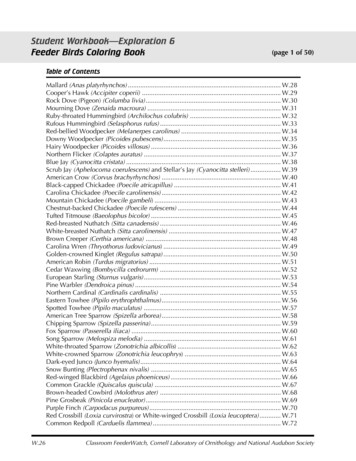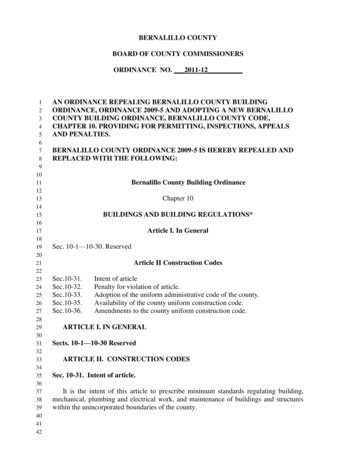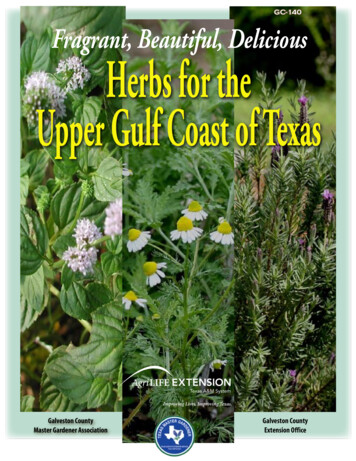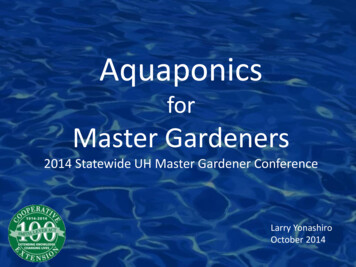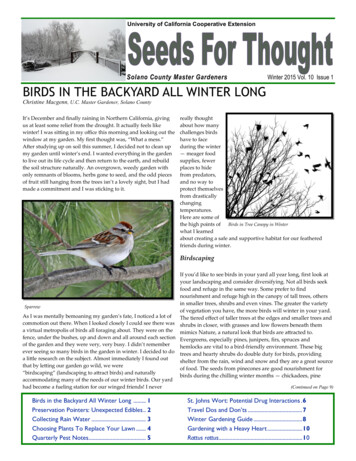
Transcription
University of California Cooperative ExtensionSolano County Master GardenersWinter 2015 Vol. 10 Issue 1BIRDS IN THE BACKYARD ALL WINTER LONGChristine Macgenn, U.C. Master Gardener, Solano CountyIt’s December and finally raining in Northern California, givingus at least some relief from the drought. It actually feels likewinter! I was sitting in my office this morning and looking out thewindow at my garden. My first thought was, “What a mess.”After studying up on soil this summer, I decided not to clean upmy garden until winter’s end. I wanted everything in the gardento live out its life cycle and then return to the earth, and rebuildthe soil structure naturally. An overgrown, weedy garden withonly remnants of blooms, herbs gone to seed, and the odd piecesof fruit still hanging from the trees isn’t a lovely sight, but I hadmade a commitment and I was sticking to it.really thoughtabout how manychallenges birdshave to faceduring the winter— meager foodsupplies, fewerplaces to hidefrom predators,and no way toprotect themselvesfrom drasticallychangingtemperatures.Here are some ofthe high points of Birds in Tree Canopy in Winterwhat I learnedabout creating a safe and supportive habitat for our featheredfriends during winter.BirdscapingIf you’d like to see birds in your yard all year long, first look atyour landscaping and consider diversifying. Not all birds seekfood and refuge in the same way. Some prefer to findnourishment and refuge high in the canopy of tall trees, othersin smaller trees, shrubs and even vines. The greater the varietySparrowof vegetation you have, the more birds will winter in your yard.As I was mentally bemoaning my garden’s fate, I noticed a lot ofThe tiered effect of taller trees at the edges and smaller trees andcommotion out there. When I looked closely I could see there was shrubs in closer, with grasses and low flowers beneath thema virtual metropolis of birds all foraging about. They were on the mimics Nature, a natural look that birds are attracted to.fence, under the bushes, up and down and all around each section Evergreens, especially pines, junipers, firs, spruces andof the garden and they were very, very busy. I didn’t rememberhemlocks are vital to a bird-friendly environment. These bigever seeing so many birds in the garden in winter. I decided to do trees and hearty shrubs do double duty for birds, providinga little research on the subject. Almost immediately I found outshelter from the rain, wind and snow and they are a great sourcethat by letting our garden go wild, we wereof food. The seeds from pinecones are good nourishment for“birdscaping” (landscaping to attract birds) and naturallybirds during the chilling winter months — chickadees, pineaccommodating many of the needs of our winter birds. Our yardhad become a fueling station for our winged friends! I never(Continued on Page 9)Birds in the Backyard All Winter Long . 1Preservation Pointers: Unexpected Edibles . 2Collecting Rain Water . 3Choosing Plants To Replace Your Lawn . 4Quarterly Pest Notes . 5St. Johns Wort: Potential Drug Interactions . 6Travel Dos and Don’ts . 7Winter Gardening Guide . 8Gardening with a Heavy Heart . 10Rattus rattus. 10
S EEDS F OR T HOUGHTWINTER 2015VOLUME 10, ISSUE 1UNEXPECTED EDIBLESPearl Eddy, U.C. Master Gardener and U.C. Master Food Preserver, Solano CountySurprises are always a lot of fun, especially when youare wandering around in the woods. It’s fun to look forwild berries, mushrooms and other special edibles. Inthe late summer you can look for the wild grapevineswhere clumps of muscadine grapes hang, ready to bemade into grape jelly. Wild blackberries can be eaten “asis” or frozen or be make into jam or pies. Gooseberriescan be made into pies. Elderberries make tasty jams,jellies and syrups.poisonous plants. For instance, the poisonous waterhemlock has flowers that resemble the edible cowparsnip. Some plants have been introduced here in thepast, such as oyster plant (salsify) with roots that tastelike oysters, the cardoon with stalks that taste likeartichokes, and chicory which has beautiful blue flowersin mid-summer. Chicory leaves can be used in salads,and the roots can be ground and used as a coffeesubstitute. Chicory was often included in the cans ofcoffee which I bought while living in the “deep south.”You do not have to leave home to find many unexpectededibles. In late winter and early spring look into yourAnother useful plant is theback yard or nearby vacant lots, and you may findbeavertail cactus which is foundminer’s lettuce, purslane, mustard greens, dandelion,not only in the deserts of thelamb’s quarter, and many other greens which are tastySouth, but also in local ruraland edible, and which provide many important vitaminsareas and back yards. The youngand minerals. Miner’s lettuce is loaded with vitamin Cflat green pads can be sliced andand helped to prevent scurvy in the miners of the goldused as a cooked vegetable, suchrush. Mustard greens are high in vitamins A, B, C andas the nopales used in Mexicanantioxidants. The newer, young leaves are best, butrecipes. The sharp spines of themore mature leaves can be used although they arepads, as well as spines of thestronger in flavor. One way to overcome the strongfruits (prickly pears) can beflavor is to simmer the leaves in water a few minutes,removed by holding the itemsOpuntia basilarispour off the water, and then finish simmering in freshwith tongs or a fork over flamesBeavertail Cactuswater. Season with salt, pepper and butter, or withfrom a gas burner, barbeque grill,or a twisted up newspaper which has been set afire.bacon.Prickly pears can be made into a butter: Peel and boilIf you will be eating some of the greens raw (such asthem until soft, strain out the seeds, add sugar if desiredwatercress), you can ensure that they are free fromand cook until somewhat thickened.microscopic organisms by soaking them for 15 minutesin a solution of ½ tsp. Clorox in one gallon of water.Another unexpected edible, although it does not growThen place them in a clear water bath for 10 minutes,wild here, are the berries of the pyracantha bush whichand then drain.many of us grow in our yards. They make a nice jelly.If you do not already recognize these and other ediblewild plants, you should obtain a reliable book or lookthem up on the internet. Two helpful sites arewww.ipm.ucdavis.edu/PMG/WEEDS, andwww.foragingpictures.com/plants. Two excellent,illustrated books are: Field Guide to Edible Wild Plantsby Bradford Angier, and Edible and Useful Plants ofCalifornia by Charlotte Clarke. This latter book givesdetailed suggestions and recipes for using the plants.The first book can be ordered from Barnes & Noble, andthe second book from www.ucpress.edu. There aremany copies of both available on line at assorted prices.It is important to be able to identify plants which youintend to eat because some edible plants resemblePAGE 2Pyracantha Jelly3 cups ripe, red berries6 cups waterJuice of l lemon (approx. 3 Tbsp.)Juice of medium-sized grapefruit (approx. ½ cup)1 pkg. powdered pectin (1 ¾ ounces)4 ½ cups sugarWash and stem berries. In a pan bring berries and waterto a boil. Reduce heat and simmer 20 minutes. Stir inlemon and grapefruit juices. Strain (but do not squeeze)through a fine, clean cloth. You should have 4 ½ cups of(Continued on Page 10)
S EEDS F OR T HOUGHTWINTER 2015VOLUME 10, ISSUE 1COLLECTING RAIN WATERTina Saravia, U.C. Master Gardener, Solano CountyIt's raining buckets,literally buckets ofwater. A lot ofplaces are gettingflooded. My ownbackyard isthreatening to dothe same.Our natural,modern dayreaction is to get thewater out of hereand send itsomewhere else out of “site”, out ofRain Collection Containersmind. But let's takePhoto by Tina Savariaa moment to thinkabout what really happens when we send all that water away.Rain comes down, travels over the roof of the house, andencounters dirt, dust, leaves, bird droppings and whatever elsehas settled there since the last downpour. The water then poursinto the gutter, down the spout and across the driveway, pickingup more dirt, debris, and engine oil, and then down the street itgoes, taking dust, animal droppings, candy wrappers and otherdebris to the river, the bay, and finally into the ocean. The fishswim in it and drink it, then we eat the fish that had beenconsuming that filthy, toxic water. I could go on and on. butthen I would start going off topic.My point is, why are we sending that precious water away,when in a few months, when the rain stops, we're going to needthat water in our own yard? This is California, and, drought orno drought, we do not get rain all year round. So why don't wecollect that water for our future use and help ease the strain onthose storm drains?There are multiple ways of collecting rainwater. They can be assimple or as complicated as you want it to be. I like to startsimple, get something going right away, and make it moreefficient as time goes by. One of the simplest ways of collectingrain water is with rain barrels. One can get a ready-made rainbarrel, hook it up to a downspout and you're set to collect rainwater.Personally, I like the DIH (Do-it-Herself) kind. I started bypurchasing some inexpensive 55-gallon food-grade containers,drilled a hole for a faucet towards the bottom of the barrel and ahole towards the top for overflow. I placed it next to thedownspout and waited for the first rain. Not perfect, but I madeit myself. And over the last 2 years, I've been perfecting them byconnecting 3 of the barrels together, and installing betteroverflow hardware.There are some basic requirements for a rain barrel. Your rainbarrel should have a spigot/faucet so that you can access thewater, an overflow pipe, a sealed and screened lid with anopening to attach your downspout, and screens on all vents.They should also have an overflow to a safe disposal location(storm water drain or rain garden).Speaking of rain gardens, this is another way of collectingrainwater. A rain garden is basically a shallow depression in thegarden filled with plants that survive both moist and dryconditions. The rain water travels through swales. Swales areshallow channels in the garden to direct the water towards therain garden. Like the rain barrels, they can be as simple orcomplicated as you want them.My own swale and rain garden originally came from a need tocreate a place to send the overflowing rainwater from a cloggedup downspout - something any first time homeowners canoverlook when cleaning the gutters for the first time. Since then,I've planted in the rain garden a Maximillian sunflower(Helianthus Maximiliano), Rush (Juncus effusus) and Californiapoppies (Eschscholziacalifornica).There are some basicrequirements for raingardens. Rain gardensshould be located at least10 feet from your houseand at least 25-40 feet froma septic system or steepslope. They should also bedesigned to drain within48-72 hours to reduce therisk of standing water and Rain GardenPhoto by Tina Savariamosquito breeding.One more way of collecting rain water and reducing run-off isby using pervious or permeable hardscape. There are many newtypes of pervious materials that allow runoff to pass throughand SINK back into the soil. Some popular choices are paverPAGE 3(Continued on Page 11)
S EEDS F OR T HOUGHTWINTER 2015VOLUME 10, ISSUE 1CHOOSING PLANTS WHEN REPLACING YOUR LAWNGene Ekenstam, U.C. Master Gardener, Solano CountyTwo previous articles in Seeds for Thought (Spring 2014 andWinter 2014) have reviewed the process for converting a lawninto a low-water-use landscape. As we worked through thisprocess with replacing our lawn, I realized that in addition tothe design and management of the hardscape, the choice ofplant material deserves careful attention.not all plants native to California are suited to all Californiamicroclimates, not all Mediterranean plants grow well or easilyin all parts of the San Francisco Bay Region.” (p.3)With this in mind, how does one build a plant list forconsideration? After all, you are trying to balance soil type,yard exposure to sun, complementary colors and heights withinIt’s not as simple asyour design. Printed sources, such as the Sunset Garden Book orwalking into athe EBMUD publication are good for starters. Sunset isnursery and askingimportant for its descriptions of the climates of Solano Countyto see drought(zones 9, 14, 15, and 17) and its section on “Plants for Drytolerant plants. JustAreas.” The EBMUD book has the advantage that its Plantwhich plants makeCatalog has a specific regional focus, but it also has beautiful fullthe most sense? Thecolor shots of nearly all the plants represented, along with verymost general answerfull cultural notes. PG&E has a descriptive folder of “Smallmight beTrees of the Bay Area” which, though not exclusively water“Mediterraneanthrifty, lists trees that will fit well in a small landscape area. Ofplants” the catch-allcourse, there are numerous web sites, starting with the UCterm for plants,Davis Arboretum list of All Stars (http://arboretum.ucdavis.edu/world-wide that arearboretum all stars) I’ve also found the Las Pilitas and Nativeadapted to periodsSons (Mediterranean and native plant nurseries) web sitesLawn Before Replacementof low rainfall.helpful in showing examples of the many varieties of a givenAll Photos in this Article by Gene EkenstamAnother, andplant family. Organizations outside California, such as thenaturally smaller,Missouri Botanic Garden, will list low-water use plants, but theycategory would be “native plants.” But at a certain level,may include some species that are not particularly suitable foraren’t those terms interchangeable? Why might the distinctionthe California climate. Such sites provide notes, photos, andbetween “Mediterranean” and “native” be significant? Well, for growth description that helped us make a choice among theat least two reasons. Many regions of the world we term asmany varieties of Arctostaphylos Manzanita for example. Finally,Mediterranean (short, mild, rainy winters and long, warm, dryof course a knowledgeable nursery staff member can be ansummers) have plants that flourish in gravelly or sandy soils,invaluable guide to the options and will tailor their suggestionsvery unlike the heavy clay soils we find in much of Solanoto yourCounty. Further, an interesting consideration in thespecificMediterranean vs. native choice is that California wildlife has colocale,-evolved with the native plants. So if the design of a garden isespecially ifmeant to encourage birds or butterflies and other pollinators,you knowMediterranean plants may be unfamiliar, or unattractive, orwhat you areeven harmful to them. For example, the berries of Nandinalooking for.domestica “Heavenly Bamboo,” originating in China and Japan,This isn’tcan be toxic to Cedar Waxwings and other birds. (Veterinaryreally a job toMedicine International ,2010, by Moges Woldemeskel and Eloisebe turnedL. Styer)over entirelyto aAs it says in the 2004 edition of Plants and Landscapes for Summercontractor orDry Climates of the San Francisco Bay Region published by the EastAfter Lawn Replacementadesigner.ItBay Municipal District (EBMUD): “ in selecting plants for theneeds the gardener’s personal involvement and judgment as toregionally appropriate garden, gardeners should compare thethe plants that will flourish best in the yard’s microclimate,native habitats of the plants they want to grow with the soilsand seasonal characteristics of their own microclimates. Just as reduce water use, and be a source of personal joy and(Continued on Page 6)PAGE 4
S EEDS F OR T HOUGHTWINTER 2015VOLUME 10, ISSUE 1Quarterly Pest Notes-HOME AND LANDSCAPE PEST INFORMATIONContributed by Dave Harper, U.C. Master Gardener, Solano CountyThe University of California (UC) Statewide Integrated PestManagement (IPM) Program provides practicalinformation on pest management techniques andidentification for a broadrange of California pests.Management suggestionsapply to California, butthey may be useful in otherareas also.PEST MANAGEMENTincludes information from other UCAgriculture and Natural Resources(ANR) resources, primarily peerreviewed UC IPM books and products,including Pests of Landscape Trees andShrubs, Pests of the Garden and SmallFarm, and Integrated Pest Managementfor Floriculture. The UC Guide toHealthy Lawns, Pesticides and WaterQuality, and the Key to IdentifyingCommon Household Ants are separatelyauthored and reviewed resources.QUICK TIPSPESTICIDE INFORMATIONQuick Tips are very shortanswer fact sheets aimed atconsumers andnonprofessionalaudiences. Compiled byUC IPM staff, Quick Tipsare drawn directly from theinformation contained inthe Pest Notes (see below) and reviewed by the originalauthors. Quick Tips are reviewed and revised when theircorresponding Pest Notes are updated.Please note that the pesticides suggestedthroughout the UC site conformed to theregistered California pesticide labels atthe time the publications were publishedor last reviewed. Pesticide registrationschange frequently at both the state andfederal levels, and UC IPM staff updatethe databases when notified. Ultimately,users are responsible for ensuring thattheir use conforms to current labels andlocal regulations. PEST NOTESPest Notes are longer publications about specific pests orpest management practices, written for home gardeners,residents, UC Master Gardeners, landscape professionals,public agency professionals, and managers of wildlandsand open spaces.Authored by University of California scientists, each PestNote is peer reviewed through the UC ANR process. As aseries coordinated by a technical editor, they follow formatand content guidelines established by the UC IPM Programand are edited, produced, and often illustrated by UC IPMstaff. Once published, each document is reviewedperiodically, typically about every 5 years, and updated asneeded.The Web site http://www.ipm.ucdavis.edu/index.htmlcan help you learn about IntegratedPest Management (IPM) and howyou can apply it to your pestproblems. UC CooperativeExtension office in Solano Countycan also help—(707) 784-1322mgsolano@ucanr.eduOTHER CONTENTReprinted with the permission of UC Davis CooperativeExtension. Find more information at:http://www.ipm.ucdavis.edu/index.htmlThe home and garden section of the UC IPM site alsoPAGE 5
S EEDS F OR T HOUGHTWINTER 2015VOLUME 10, ISSUE 1HEAVENLY SCENTJennifer Baumbach, U.C. Master Gardener Program Coordinator, Solano CountyAsk any gardener what their favorite plant is and I bet youwill find they can’t name just one. Count me in thatgroup. I love plants. But there are a few stand-outs thatare worth mentioning.For me, what captures my interest is either the color orsmell of a plant. I love bright colors. Mostly oranges andblues. But I think that fragrance is the top attribute I lookfor in plants to add to my yard.shrub grows about 5 feet tall and 8 feet wide. Mine is notthat wide, but its arching branches are long. At first, I didn’t think this plant would do well in my garden, but aboutthe third year, it took off. It puts off this lovely apricotscent and perfumes the yard when the winds blow to theNorth. I hope to put in another of these delightful shrubsfor an even more intense treat for the nose.I recommend you open up your senses and try picking outplants with interesting fragrances to add to your ownWhen I was attending Cal Poly, San Luis Obispo, I learned yards. You’d be amazed at what’s out there.of this plant called Psoralea pinnata also known as theScurfy Pea or the Kool-Aid Bush. I had never encountered such a plant before. This was way back when I wasjust getting in to Horticulture, I was a late-bloomer withrespect to learning or loving plants! What caught myattention is the smell of the flowers. They smelled likegrape Kool-Aid ! Seriously! The plant is somewhat uglyand rangy, but the blue and white flowers made up forthat.Since then, I have found a prettier substitute for the ScurfyPea. This plant is in one of my favorite genuses, Salvia.The plant is Salvia melissodora known as the Grape-scentedsage. It is a shrub that can get to 8 feet tall. It is native tothe upper elevations of Mexico. The leaves also have aninteresting smell, but not as good as the grapey fragranceof the violet/lavender flowers. To enjoy the smell, youhave to avoid bruising the leaves, so don’t touch, just sniff.But be careful, as the carpenter bees and other bees visitthis plant frequently. You don’t want a sting on yoursniffer!I have two of these salvias planted just outside my window. In the warm evenings of the summer, you can smelltheir delightful grape scent as it perfumes the neighborhood and of course, inside my home. They also bloomnow and when the weather is warm enough, like our 60degree winter days, the bees will be working the flowers.Another favorite of mine is the Mock Orange (Philadephus‘Belle Etoile’). This is a late spring-early summer bloomer.It has white-petaled flowers with a maroon center. ThePAGE 6Salvia melissodora (above) and Philadelphus ’BelleEtoile’ (below) (photos by Jennifer Baumbach)
S EEDS F OR T HOUGHTWINTER 2015VOLUME 10, ISSUE 1TRAVEL DOS AND DON’TSRiva Flexer, U.C. Master Gardener, Solano CountyIt’s happened to all of us you’re on vacation. Then you see it,and you have to have a piece. Just last week, it was.in Maui.My first thought was “how can I carry a piece back to myapartment?” The second? “Hands off, Riva!” I had thisconversation with myself daily on that trip. The gingers, and allsorts of hibiscus, the enormous banks of bougainvillea, areeverywhere, and in Mount Haleakala National Park, one seesplants found nowhere else on this planet.The Spotted WingDrosophila(Drosophilasuzukii) is arelatively newimport (first seenin 2008) that laysits eggs inripening (notBut you can’t take them home just like that. Why not? My littleripe) raspberries,plant won’t cause any problems! Ah, but it can, all too easily.cherries,That small seed or cutting is host to microscopic organisms.blueberries,Hylocereus undataHave you ever looked at seed packets for spices? Often they will Photo by Riva Flexerblackberries,specify that the contents have been sterilized. That is to ensureplums, plumcots,that should these seeds be planted unintentionally they contain nectarines and figs. The Asian Citrus Psyllid is a carrier of Citrusno microscopic organisms that do not belong here, organismsgreening disease, which has the capability to decimate our citrusfound on the plant or in the soil where it originated.industry. The light brown apple moth (found in Australia, NZNew Caledonia, Hawaii, UK, and Ireland) has been found inEither the plant itself, or those microorganisms living on it or in Solano County, affecting grapes, citrus, pome fruits and stonethe soil fragments in which it originated, can become an invasive fruits.pest. In its native environment, there are checks and balances inthe ecosystem. Transfer that collection of life forms to a newSo, how does one avoid this problem in the first place?environment, and poof! You have an exotic species and anythingcan happen.1. Don’t bring plants or soil home and be aware that youmight be inadvertently carrying excess baggage.Exotic species are organisms (plants, animals, andmicroorganisms) that are not native to a particular region. They If you are travelling to a contaminated area, ensure that you arehave been introduced accidentally or intentionally. Their impact not contaminating your home region when you return. Cleanvaries considerably depending on the species and the area being your footwear and don’t spread species from that region toinvaded. Some species have been imported to clear up anyours. It’s just basic cleanliness.agricultural or animal problem. Others have simplypiggybacked in, or may have been brought by homesickWhen entering California from Nevada, you may recallimmigrants. For many of these organisms, California provides a agricultural check points on the highways at the point of entry.wonderful place to live and prosper, with no natural predators. This is to keep unwanted pests out. A similar arrangement canThey then become invasive. Wild anise, star thistle and pampas be seen at airports. When one is returning to the United States,grass, all of which thrive in Solano County are imports. Even aCustoms and Excise officers will ask if you have visited a farmnursery plant, sold for home gardens, can inadvertently become in the last two weeks, or if you are carrying seeds or plants ora pest species because it reproduces vigorously and has noagricultural material. One year, it happened to me – I waspredators. Purple Loosestrife (Lythrum salicaria) and big-leavedreturning from a holiday and had not emptied my pocketsPeriwinkle (Vinca major) are used in landscaping, and bothwhich still contained seeds I had automatically harvested. Uponspread rapidly, choking out native plants, with no naturalbeing asked if I had any plant material on me, I had to say “yes”,predators.and subsequently spent too much time in a small roomexplaining why I had not emptied my pockets before enteringExotic and pest insects and microorganisms are particularlysterile space.dangerous here. California is home to a vibrant agriculturaleconomic sector. We grow cherries, peaches, plums, dates and2. Research what you want to plant.citrus, just to name a few major food crops. At least three ofNative plants are best adapted to our Mediterraneanthese are under threat from unintentionally imported speciesenvironment, as are Mediterranean plants. Purchase fromand organisms which have become serious agricultural pests.(Continued on Page 11)PAGE 7
S EEDS F OR T HOUGHTWINTER 2015VOLUME 10, ISSUE 1WINTER GARDENING GUIDEJANUARY PLA NT IFEBRUARYSow California poppy(Eschscholzia californica) seedsfor spring colorSow indoors cool-seasonedibles such as chard, kale,and lettucePlant winter blooming shrubs:purchase now while in bloomto see what you are gettingHarvest citrus as it ripens—taste for flavor Prune deciduous plants whiledormant to keep grapes, roses,fruit and shade trees shapelyCheck mulch. Add more topaths and beds for weedsuppressionProtect tender plants whencold nights are predicted.Water well—dry plants aremore susceptible to frostdamageFertilize azaleas after bloom;cymbidiums with 1/2 strengthfertilizer every week or soCollect rain water to use onyour garden Control snails and slugs byeliminating hiding places, orhand pickUse a dormant spray to controlover wintering insects ondeciduous plants. Controlpeach leaf curl with lime sulfuror fixed copper. Followdirections for properapplicationSpray roses with dormant oil tocontrol over wintering insectssuch as aphids, mites andscale. Thoroughly coat trunk,branches and twigs NMARCHPlant summer bulbs such asgladioli, cannas, ranunculus,anemone, dahlia, lily, tuberousbegonia and delphiniumPlant leaf crops like lettuce,spinach, cilantro, beets, carrots,chard, lettuce, peas, and spinachdirectly in the groundIndoors, start seeds of eggplant,peppers, and tomatoes. Transplantoutdoors in 6 to 8 weeksPlant berries, raspberry,boysenberry and blackberry Pinch fuchsias through March; forevery stem you pinch, you’ll get 2;for every 2, you’ll get 4Fertilize: citrus and fruit trees,cane berries, roses (only after yousee new growth begin)Fertilize fall planted annuals andperennials, and established treesand shrubs with an all-purposefertilizer. Wait on azaleas,camellias and rhododendrons untilafter bloomMulch exposed areas to preventweed seeds from germinatingRepot cymbidiums if necessary Snails and slugs are dormant twotimes a year, during the hottestpart of summer and during thecoldest weeks in winter. This isabout the time they head out forfeeding. Get out early and pickDon’t prune out any frostdamaged growth for anothermonth or so—the outer deadfoliage may protect healthygrowth beneath from further frostdamage Almost any plant (except tropical) can beplanted now. Start seeds of old-fashionedfavorites such a apricot foxglove,bachelor’s button, blue flax and Orientalpoppies. Summer sizzlers like cosmos andzinnias also grow more vigorously from aseed start and catch up fast to nurserystarted plants.Plant warm season annuals like ageratum,marigold, petunia and sunflowerSwitch out cool-season vegetables forcorn, beans, peppers and tomatoesGMAINT ENAN C Fertilize almost everythingFlowering and fruiting plants needphosphorus-rich fertilizerGreen leafy plants such as lawns andlettuce require nitrogenRoot plants such as potatoes, beets, andbulbs appreciate a handful of potassium.Read the labelsOnce soils have dried out, give yourirrigation system a tune up. Then set towater deeply and infrequently toencourage deep root growthEPRE VENTIO NPAGE 8 Now is the time to get a jump on insectinfestations: check for signs of aphids(distorted new growth and tiny, oftengreen or black insects) and spittle bugs(under white foam on stems). Both can beeffectively sprayed off with a garden hoseHandpick snails at night, or use bait—follow all directions
S EEDS F OR T HOUGHTWINTER 2015(Continued from page 1--Birds in the Backyard All Winter Long)siskins, grosbeaks and woodpeckers love them. Deciduous treesmay lose their leaves and not provide much shelter but theyoffer something else that is valuable. Nuts. Oaks (Quercus),walnuts (Juglans regia), hickories (Carya), and hazelnuts(Corylus), all produce rich fuel for birds.Berry DeliciousVOLUME 10, ISSUE 1attract sparrows and juncos, who’ll work overtime on those pilesdoing bug cleanup. The more bugs you have, the more plentifulbirds will be in your garden. Mother Nature designed it thisway.Let’s not forget worms. For many birds, worms
wild berries, mushrooms and other special edibles. In the late summer you can look for the wild grapevines where clumps of muscadine grapes hang, ready to be made into grape jelly. Wild blackberries can be eaten "as is" or frozen or be make into jam or pies. Gooseberries can be made into pies. Elderberries make tasty jams, jellies and syrups.

